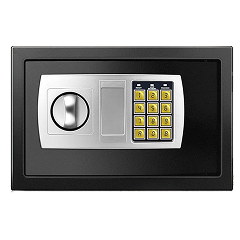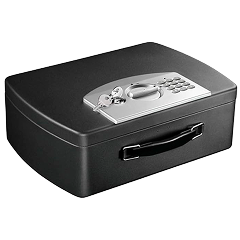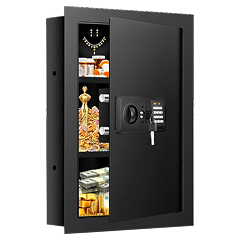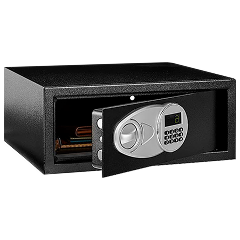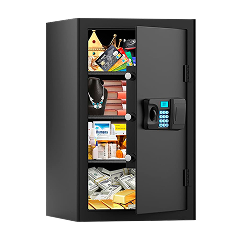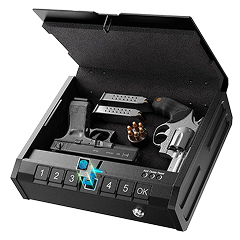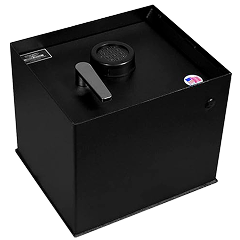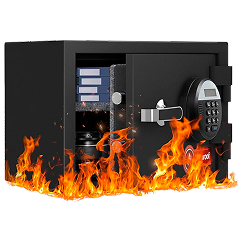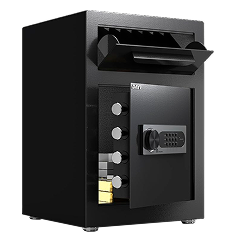As an engineer and homeowner, I’ve learned that protecting valuables goes beyond just locking your front door. After researching home security options and living with two different safes for several years, I can tell you that a dedicated jewelry safe offers protection that a bedroom drawer or even a basic lockbox simply can’t match.
The peace of mind alone justifies the investment, especially when you consider how quickly burglars work. They spend an average of 8-10 minutes in a home, grabbing obvious targets before moving on.
My personal experience includes an 80-pound combination safe that requires patience but offers reliable security, and a portable keyed fire safe that I originally bought for documents but works well for smaller valuables. Neither setup is perfect, which is exactly why this guide exists.
Our main home safe buyer’s guide tackles the big picture of residential security. However, this one gets specific about jewelry storage: rings, necklaces, watches, and the other stuff burglars grab first. I’ll share the technical details that matter, what I’ve figured out from using my own safes, and where I went wrong so you don’t have to.
Fire Protection Ratings Explained
When I bought my first fire safe, I assumed all fire ratings were created equal, that turned out to be an incorrect assumption. Fire protection for jewelry requires much higher standards than what protects paper documents.
Your birth certificate can handle heat that would destroy expensive jewelry. Gold starts melting at 1,948°F, silver liquefies at 1,763°F, and lots of gemstones crack or change color long before those temperatures. My keyed fire safe claims basic fire resistance, but after researching the actual testing standards, I realized it probably wouldn’t save expensive jewelry in a real house fire.
The UL (Underwriters Laboratories) ratings give you the real story about what your safe can actually withstand. These aren’t marketing claims, they’re based on standardized tests that simulate actual fire conditions. Here’s what the ratings mean for jewelry protection:
- UL Class 350 (1-hour): Interior stays below 350°F for one hour—protects paper but insufficient for most jewelry
- UL Class 350 (2-hour): Interior stays below 350°F for two hours—minimum recommended for valuable jewelry
- UL Class 150 (1-2 hours): Interior stays below 150°F—premium protection for all jewelry types and digital media
UL ratings cost more upfront but save money long-term when you consider replacement costs. My combination safe lacks any UL certification, which I regret every time I think about the wedding rings stored inside during our vacations.
Choosing the Right Lock Type
After years of fumbling with my combination dial in dim light and worrying about lost keys, I’ve developed strong opinions about lock mechanisms. Each mechanism comes with trade-offs you won’t appreciate until you’ve lived with them daily. What drives you crazy might not bother someone else at all.
Mechanical Combination Locks
My 80-pounder uses a traditional three-number combination dial, and while it’s taught me patience, it’s also shown me this lock type’s reliability. Zero batteries, no electronics, no keys to misplace; just you and the dial working together.
The frustration comes when you’re rushed: combinations demand slow, careful turns, and changing the code involves steps so complicated I’ve never bothered trying. But when storms knock out power or fancy electronics fail, this old-school setup keeps working.
Key Locks
The portable model uses a simple key lock, which I chose for quick access during emergencies. Keys work fast—insert, turn, done—and there’s something reassuring about the mechanical simplicity. Problems surface immediately: I’ve already had to make backup keys after nearly losing the originals, and I constantly worry about someone duplicating them.
Plus, keys offer minimal security against determined thieves who know basic lock-picking techniques. Still, for a secondary safe or situations where speed matters more than maximum security, key locks serve their purpose well.
Digital and Biometric Locks
I haven’t owned either type, but my research shows you’re trading convenience for complexity. Digital locks let you program multiple codes and change them easily, something I wish I could do with my combination unit.
Biometric locks sell themselves as the ultimate convenience, your finger opens the door. But both need batteries that die at terrible times, and electronic parts break in ways mechanical systems don’t. Users complain about biometric readers that won’t recognize dirty, wet, or aging fingerprints.
Jewelry-Specific Storage Features
Interior layout matters as much as the lock, keeping thieves out.
Interior Organization Options
Dumping jewelry into an empty safe turns into a nightmare fast. Chains tangle together, metals scratch against each other, and you’ll waste time hunting for that one earring.
Good jewelry safes solve this with compartments, ring slots, and hooks that keep pieces separated. Ring slots stop bands from scraping together, while hooks prevent necklace disasters. My combination unit came with basic shelving that works for bigger stuff, but I ended up buying small containers to organize rings and earrings properly.
Lined Interiors and Scratch Prevention
The hard steel interior of my older safe scratches everything it touches, which I learned the hard way with a watch that now bears permanent marks. Nicer safes come with velvet or felt that protects jewelry from metal contact and scratching.
Soft interiors also quiet things down when items move around; you’ll appreciate this if your safe sits near where people sleep. The lining should come out for cleaning since dust builds up over time—my fixed shelves make this impossible.
Matching Features to Your Collection
What you actually own dictates storage needs, not what looks impressive in product photos. If you collect watches, prioritize padded slots that accommodate different band styles. Ring collectors need multiple ring rolls with various slot sizes.
Those with long necklaces require sufficient height and hooks to prevent tangling. My modest collection fits my basic setup, but friends with extensive jewelry complain about safes that looked perfect online but couldn’t accommodate their specific pieces in real life.
Size and Portability Tradeoffs
Space planning for a safe involves more than measuring your jewelry collection. You’re balancing security, accessibility, and the physical reality of your home. My 80-pound combination safe sits exactly where the delivery team placed it, because moving it requires serious planning and probably help from friends.
The weight stops thieves from carrying it off, but I’m stuck with wherever I first put it. My portable fire safe weighs maybe 15 pounds and moves around easily in closets, under beds, travel bags, wherever I need it.
You need more than just cubic footage; the interior has to work for jewelry organization. Tall, narrow designs work great for documents but leave you struggling to arrange jewelry sensibly. My combination safe looked spacious until I started filling it with jewelry boxes, then it felt cramped fast. Jewelry spreads out more than it stacks up, so width beats height for most collections.
Portable safes trade security for convenience. The lightweight model works great for temporary storage or travel, but I’m always aware that someone could grab the whole thing if they found it. Thieves know this too; they’ll steal portable safes and crack them open later in private. I’ve found the sweet spot at a safe heavy enough to discourage casual theft, but not so massive that you can’t reposition it when rearranging furniture or moving homes.
Mounting and Installation Options
Pre-drilled mounting holes exist on most safes for good reason; bolting down your safe transforms it from a heavy box into a permanent security fixture. My safes remain unanchored, which I admit represents a security compromise I made due to my own reluctance to drill into my floors and commit to permanent placement.
Thieves with hand trucks or multiple people can defeat even heavy safes that aren’t secured to the structure. Bolting also stops safes from tipping during earthquakes or when thieves try prying them open with leverage.
I lack hands-on installation experience, but I know of several mounting approaches that work for different situations. Here’s how DIY installation compares to professional services:
Common mounting options:
- Floor anchoring: Bolts through the bottom into the concrete or wooden subfloor—most secure option
- Wall mounting: Smaller safes can attach to wall studs—saves floor space but limits size
- Inside closets: Provides concealment while allowing floor or wall mounting
- Basement installation: Maximum security but potentially reduced accessibility
Quality Considerations for Jewelry Safes
Steel thickness determines how long your safe can resist attack methods that criminals actually use, like angle grinders, drills, and pry bars, rather than Hollywood-style explosives. My older combination safe feels solid but lacks the specifications I’d want in a new purchase, while the fire safe prioritizes lightweight portability over security features.
Quality safes need thick steel walls (minimum 1/4 inch), heavy doors (1+ inches), and several locking bolts that distribute pressure across the frame instead of creating weak spots. Recessed doors prevent pry bar attacks, while powder coating lasts longer than regular paint.
Maintenance and Troubleshooting Tips
Regular maintenance prevents lockouts that always happen when you’re in a hurry.
- Electronic lock batteries: Replace batteries twice yearly before they fail—dead batteries trap you outside your own safe until you find the override key.
- Combination lock lubrication: Apply graphite to the dial and bolts annually to prevent the sticky, frustrating operation I deal with on my combination safe.
- Interior lining inspection: Check fabric or velvet lining for rips, wear, or dust buildup that scratches jewelry, replacing it when protection degrades.
- Documentation and support: Store purchase papers and manufacturer contacts where you can find them—safe malfunctions need specialized knowledge that regular repair shops lack.
Budgeting for Your Jewelry Safe
Price ranges vary dramatically based on features that actually matter versus marketing gimmicks that sound impressive but add little real value.
Fire-resistant safes with key locks start around $50-$150, while my combination safe costs about $200 and delivers solid security for its size class.
Moving up to UL-rated fire protection and digital locks pushes prices into the $300-$800 range, and biometric systems with premium steel construction can exceed $1,000. The temptation exists to buy cheap and upgrade later, but I’ve learned that replacing an inadequate safe costs more than buying the right one initially.
Collection value should guide your investment, but don’t forget to factor in replacement hassle and sentimental worth that insurance can’t cover. A $500 safe protecting $5,000 in jewelry makes financial sense, but even modest collections justify spending more for peace of mind and convenience features you’ll use daily.
My fire safe works fine for documents and emergency cash, while my heavier combination safe handles the items I’d genuinely worry about losing. I’ve found the sweet spot at buying slightly more protection than you think you need today, since jewelry collections tend to grow over time, and moving up to a larger safe later means dealing with installation twice.
Making Your Final Decision
Your actual security needs trump flashy feature lists or big brand names. Living with a safe every day shows you what really matters, not what sounded good in the product description.
Will you actually use digital quick-access daily, or do you value my combination dial’s reliability more? Consider your collection’s worth now and later, your available space, and be realistic about which features you’ll use versus the ones that just sound impressive. Pick the safe that fits your actual routine and security requirements, not the one loaded with extras.
Our main guide covers safe manufacturers, general security principles, and broader home protection strategies if you need that foundation knowledge. When you’re ready to buy, talk to a security professional if you’re protecting valuable items or dealing with tricky installation situations.
They spot problems and suggest fixes that general advice misses. Focus on quality and reliability over fancy convenience features when protecting irreplaceable items. Buy adequate protection now to avoid the regret I carry about my unanchored safes and weak fire ratings.


